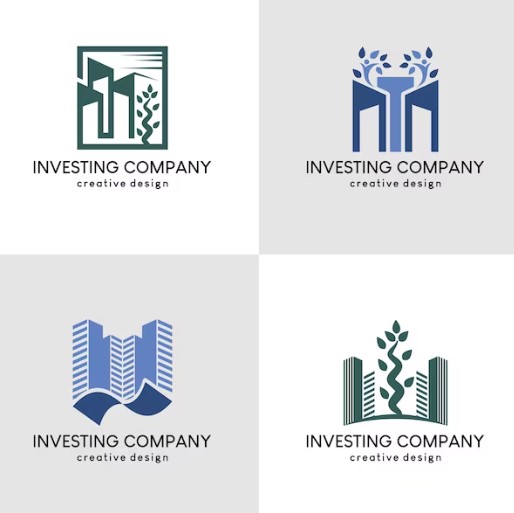Investment Company Logo – What is the significance of a logo for investment companies? In the fiercely competitive landscape of the financial sector, a logo serves as the visual cornerstone of a company’s identity. It encapsulates the essence of the brand, communicating its values, mission, and credibility to stakeholders. But why exactly does a logo matter in the financial sector?
Importance of Investment Logos

The importance of investment logos cannot be overstated in today’s competitive financial landscape. These logos serve as the visual representation of investment companies, encapsulating their identity, values, and mission in a single symbol. Here’s a deeper look at why investment logos are so crucial:
- Establishing Brand Identity in the Competitive Market: In a crowded marketplace where numerous investment firms vie for attention, a well-designed logo acts as a powerful tool for differentiation. It helps companies stand out from the competition by creating a distinct visual identity that is easily recognizable and memorable.
- Building Trust and Credibility with Stakeholders: Trust is paramount in the world of finance. A professionally designed logo conveys a sense of professionalism, reliability, and competence, instilling confidence in investors, clients, and partners. It serves as a visual reassurance of the company’s integrity and commitment to excellence.
- Reflecting Company Values and Mission: A logo is more than just a graphic; it’s a reflection of the company’s core values and mission. Through carefully chosen elements such as colors, symbols, and typography, a logo communicates the essence of the brand and what it stands for. It serves as a visual representation of the company’s ethos, culture, and aspirations.
- Creating Brand Recognition and Recall: A strong logo becomes synonymous with the brand it represents. Through repeated exposure, it becomes ingrained in the minds of stakeholders, fostering brand recognition and recall. This recognition is essential for building brand loyalty and attracting new business opportunities.
- Differentiating from Competitors: In a competitive market, differentiation is key to success. A well-crafted logo helps investment companies distinguish themselves from competitors by showcasing their unique value proposition, strengths, and expertise. It sets them apart in the minds of investors and clients, making them the preferred choice in a crowded field.
- Facilitating Marketing and Communication Efforts: Logos play a pivotal role in marketing and communication efforts. They serve as the cornerstone of a company’s visual identity, appearing on everything from business cards and letterheads to websites and advertisements. Consistent use of the logo across various channels helps reinforce brand messaging and creates a cohesive brand experience for stakeholders.
Characteristics of an Effective Logo
The characteristics of an effective investment company logo are pivotal in ensuring its success as the visual representation of a brand. Here’s an in-depth exploration of what makes a logo truly impactful:
- Simplicity and Memorability: The most effective logos are often the simplest. A clean and uncomplicated design ensures easy recognition and recall, even amidst a sea of competing visuals. Memorable logos are those that can be easily remembered and recalled by consumers, helping to imprint the brand in their minds.
- Relevance to the Investment Sector: A logo must resonate with the target audience, especially in the investment sector. Incorporating elements that are relevant to finance, such as currency symbols, graphs, or abstract representations of growth, helps establish a connection with investors and financial professionals.
- Versatility Across Different Platforms: A logo should be versatile enough to adapt to various mediums and sizes without losing its impact or legibility. Whether it’s displayed on a billboard, business card, or digital screen, the logo should maintain its integrity and visual appeal across all platforms.
- Timelessness for Long-term Recognition: While trends may come and go, a timeless logo withstands the test of time. It avoids being tied to a specific era or style, ensuring that it remains relevant and recognizable for years to come. Timeless logos have a timeless quality that transcends fleeting fads.
- Uniqueness to Stand Out Among Competitors: In a crowded marketplace, originality is key. A distinctive logo sets the company apart from competitors, capturing attention and fostering brand loyalty. Unique logos create a memorable impression on consumers, helping to differentiate the brand from others in the industry.
By embodying these characteristics, an effective logo becomes more than just a visual symbol; it becomes a powerful asset that reinforces brand identity, builds recognition, and distinguishes the company in the marketplace.
Elements of a Successful Investment Logo
The elements of a successful investment company logo play a crucial role in conveying the essence of a financial brand while resonating with its target audience. Here’s a detailed exploration of the key elements that contribute to the effectiveness of an investment logo:
- Typography: Typography refers to the style, arrangement, and appearance of text within the logo. In investment logos, typography should strike a balance between professionalism and readability. Serif fonts often convey a sense of tradition and reliability, while sans-serif fonts can evoke modernity and innovation. The choice of typography should align with the brand’s personality and values, ensuring that the logo communicates the right message to stakeholders.
- Color Scheme: Colors play a significant role in logo design, as they evoke emotions and associations that can influence perception. In the investment sector, colors such as blue and green are commonly used to convey stability, trustworthiness, and growth. However, the choice of colors should be strategic and reflective of the brand’s identity and target audience. A cohesive color scheme ensures visual harmony and reinforces brand recognition across various touchpoints.
- Iconography or Symbols: Iconography refers to the use of symbols or visual elements within the logo to convey meaning or represent the brand. In investment logos, common symbols may include abstract representations of financial concepts such as arrows, graphs, or currency symbols. These symbols should be carefully chosen to align with the brand’s values and resonate with its target audience. When used effectively, icons can enhance the logo’s visual appeal and communicate complex ideas in a simple and intuitive manner.
- Overall Design Composition: The composition of a logo refers to the arrangement and organization of its various elements, including typography, symbols, and shapes. A successful investment logo achieves visual balance and harmony through thoughtful composition, ensuring that each element complements the others without overwhelming the viewer. Clear hierarchy and alignment help guide the viewer’s eye and create a cohesive and visually pleasing design.
By incorporating these elements into the design process, investment logos can effectively communicate the brand’s identity, values, and mission while resonating with stakeholders and fostering brand recognition and trust.
Best Practices in Logo Design
When it comes to investment company logo design for investment companies, following best practices is essential to create a visually appealing and impactful emblem that accurately represents the brand. Here’s an in-depth look at the best practices in logo design:
- Conducting Market Research and Competitor Analysis: Before diving into the design process, thorough research is essential. Analyzing competitor logos and market trends provides valuable insights into what resonates with the target audience and helps identify gaps or opportunities for differentiation. Understanding the competitive landscape ensures that the logo stands out while remaining relevant within the industry.
- Collaborating with Professional Designers: While DIY tools are available, investing in professional design expertise yields superior results. Experienced designers bring creativity, technical skill, and industry knowledge to the table, ensuring that the logo accurately reflects the brand’s identity and resonates with its audience. Collaborating with designers allows for a collaborative process that incorporates diverse perspectives and expertise.
- Balancing Creativity with Professionalism: A successful logo strikes the delicate balance between creativity and professionalism. While it’s important to create a visually striking design that captures attention, it’s equally crucial to maintain a sense of professionalism and credibility. Avoiding overly complex or gimmicky designs ensures that the logo remains timeless and adaptable across various applications.
- Ensuring Scalability for Various Applications: From business cards to billboards, a logo must remain legible and impactful at any size. Designing with scalability in mind prevents distortion and pixelation, ensuring that the logo maintains its integrity across diverse platforms and mediums. Vector-based formats such as SVG or EPS are ideal for maintaining sharpness and clarity at any scale.
By adhering to these best practices, investment company logo can create logos that effectively communicate their brand identity, values, and mission while resonating with stakeholders and fostering brand recognition and trust.
